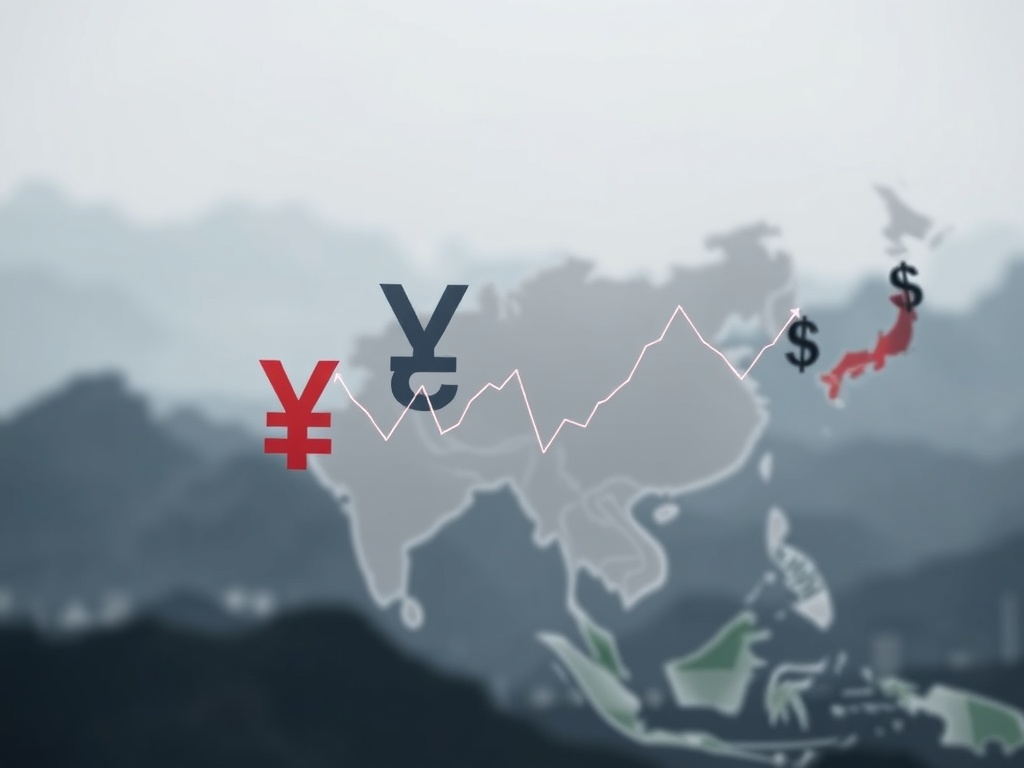Asia FX: Decoding the Future Amidst Fed Rate Cuts and Geopolitical Risks
0
0

BitcoinWorld

Asia FX: Decoding the Future Amidst Fed Rate Cuts and Geopolitical Risks
In the dynamic world of digital assets, understanding the pulse of traditional financial markets, particularly currency movements, is paramount. While Bitcoin and altcoins often chart their own course, the underlying currents of global macroeconomics, interest rate policies, and geopolitical events profoundly influence investor sentiment across all asset classes. Today, we turn our attention to the subdued performance of Asia FX and the US Dollar, as market participants grapple with the complex interplay of anticipated Fed Rate Cuts and simmering Geopolitical Tensions. For crypto investors, these shifts in the Global Economy can signal broader liquidity trends, risk appetite, and potential arbitrage opportunities.
Asia FX’s Current Stance: Why the Subdued Performance?
The landscape for Asia FX has been remarkably calm, perhaps too calm for some. This subdued behavior isn’t a sign of inherent stability, but rather a reflection of a market caught between conflicting forces. Many Asian currencies, from the Japanese Yen to the Korean Won and the Chinese Yuan, have shown limited directional conviction. This largely stems from a cautious approach by central banks in the region, often waiting for clearer signals from major economies, especially the United States.
Several factors contribute to this cautious stance in Asia FX:
- Cautious Central Banks: Many Asian central banks are hesitant to make significant policy shifts. They often prefer to maintain competitive export positions or manage inflation carefully, avoiding moves that could destabilize their economies without clear global cues.
- Trade Dependencies: Asian economies are heavily reliant on global trade. This makes their currencies sensitive to shifts in global demand, supply chains, and the economic health of their major trading partners, particularly the United States and Europe.
- Capital Flows: Investor flows into and out of the region are heavily influenced by interest rate differentials and risk perceptions. Uncertainty about future global interest rates or increased Geopolitical Tensions can lead to capital flight, impacting local currencies.
The lack of aggressive policy action or significant economic surprises in Asia has kept its currencies largely range-bound, waiting for a definitive catalyst from global events.
The US Dollar’s Dilemma: Navigating Fed Expectations and Global Crosscurrents
The US Dollar, the world’s primary reserve currency, finds itself in a peculiar state of flux. Despite persistent inflation concerns and a robust job market, the dollar has largely remained range-bound, oscillating as investors weigh various factors. The dollar index (DXY), which measures the greenback against a basket of major currencies, reflects this indecision. Its performance is intricately tied to market expectations surrounding the Federal Reserve’s monetary policy and the broader Global Economy.
Key drivers influencing the US Dollar‘s movements include:
- Economic Data: Stronger-than-expected US economic data, such as robust employment figures or higher inflation prints, often supports the dollar. This is because it suggests the Fed might keep interest rates higher for longer. Conversely, weaker data can pressure the dollar, increasing expectations for Fed Rate Cuts.
- Safe-Haven Demand: In times of heightened global uncertainty, whether economic or geopolitical, the dollar often benefits from its status as a safe-haven asset. It attracts capital flows from investors seeking stability amidst turmoil.
- Interest Rate Differentials: The gap between US interest rates and those in other major economies directly impacts the dollar’s attractiveness to yield-seeking investors. A widening positive differential typically strengthens the dollar, while a narrowing one can weaken it.
The market’s continuous reassessment of these factors creates a dynamic environment for the US Dollar, making its short-term direction often difficult to predict.
Fed Rate Cuts: The Central Bank’s Pivotal Role in Currency Dynamics
Perhaps no single factor dominates currency market discourse more than the prospect of Fed Rate Cuts. After an aggressive tightening cycle aimed at combating inflation, the market is now fixated on when and how many times the Federal Reserve will lower its benchmark interest rate. This anticipation directly influences bond yields, which in turn affect the relative attractiveness of holding dollar-denominated assets versus those in other currencies, significantly impacting Asia FX and other global currencies.
The implications of anticipated Fed Rate Cuts are far-reaching:
- Yield Compression: Lower US interest rates would reduce the yield advantage of US bonds and other interest-bearing assets. This could potentially make the dollar less appealing to international investors who seek higher returns, leading to capital outflows.
- Risk Appetite: Easier monetary policy by the Fed is often seen as supportive of riskier assets, such as equities and commodities. This environment could potentially divert capital away from the dollar into emerging market currencies or other higher-beta assets, including cryptocurrencies.
- Global Spillover: The Fed’s decisions have a significant spillover effect, influencing other central banks’ policy considerations. If the Fed cuts rates, it might create room for other central banks to ease their own policies, impacting global interest rate differentials and the broader Global Economy.
The market’s expectations for these cuts often diverge from the Fed’s own projections, creating volatility. Investors are constantly analyzing economic data for clues on the Fed’s next move, with every piece of inflation or employment data scrutinized for its potential impact on the timing and pace of rate adjustments.
Geopolitical Tensions: An Unpredictable Variable for Global Markets
Beyond economic fundamentals, Geopolitical Tensions continue to cast a long shadow over currency markets. From ongoing conflicts in Eastern Europe and the Middle East to simmering disputes in the Indo-Pacific, these uncertainties introduce an unpredictable element into financial calculations. Such tensions can trigger sudden shifts in investor behavior, leading to flight-to-safety movements and impacting currencies like the US Dollar and regional currencies in Asia.
The impact of Geopolitical Tensions includes:
- Safe-Haven Flows: Periods of heightened geopolitical risk often see investors flock to perceived safe havens. The US Dollar, Japanese Yen, and Swiss Franc typically benefit from this demand, attracting capital even if their own domestic economic situations are not stellar.
- Supply Chain Disruptions: Conflicts or political instability in key regions can disrupt critical supply chains. This can lead to inflationary pressures due to increased costs and shortages, impacting trade balances and, in turn, affecting currency valuations, especially for import-dependent nations.
- Energy Price Volatility: Many geopolitical hotspots are in energy-producing regions. Disruptions can cause oil and gas price spikes, which significantly impact import-dependent nations and their currencies. Higher energy costs can also feed into inflation, influencing central bank policy.
These tensions introduce a layer of complexity that economic models alone cannot fully capture, making market reactions often swift and sharp.
The Global Economy’s Interconnected Web: How Everything Links Together
The currency market is a complex ecosystem where every major factor—from interest rate expectations to geopolitical developments—is interconnected, forming the intricate web of the Global Economy. The subdued nature of Asia FX and the indecision of the US Dollar are not isolated incidents; they are symptoms of a larger global economic narrative where all elements influence each other.
Consider these critical interdependencies:
- Inflationary Pressures: Geopolitical events can fuel inflation through commodity price surges (e.g., oil). This, in turn, can force central banks (including the Fed) to maintain tighter monetary policies or delay Fed Rate Cuts, directly impacting interest rate expectations and currency strength.
- Growth Differentials: Varying growth prospects across regions, influenced by trade policies, domestic demand, and investment climates, directly affect currency strength. A stronger growth outlook typically attracts foreign investment, bolstering the local currency. This also influences the relative performance of Asia FX versus the US Dollar.
- Cross-Border Capital Flows: The global search for yield, combined with risk assessments, drives capital across borders. Expectations of Fed Rate Cuts can prompt investors to reallocate funds from the US into higher-yielding emerging markets or other asset classes, impacting their currencies and the overall health of the Global Economy.
Understanding these relationships is crucial because a change in one area can trigger a cascade of effects across the entire financial system.
Challenges and Opportunities for Investors in a Volatile Landscape
Navigating this intricate landscape presents both challenges and opportunities for investors, including those in the cryptocurrency space. The primary challenge is the sheer unpredictability. While economic data provides a roadmap, sudden geopolitical shocks or unexpected shifts in central bank rhetoric can quickly alter market dynamics, making it difficult to maintain consistent strategies.
However, for the astute investor, opportunities abound:
- Diversification: Understanding currency movements allows for better portfolio diversification. By strategically allocating assets across different currencies or hedging against currency risk, investors can potentially mitigate losses in one area with gains in another.
- Strategic Entry/Exit: For crypto traders, recognizing periods of dollar strength or weakness can inform decisions on stablecoin holdings versus volatile digital assets. A strong dollar might encourage stablecoin accumulation, while a weakening dollar could favor riskier crypto assets.
- Arbitrage Potential: Discrepancies in currency valuations across different markets or between traditional and digital assets can create short-term arbitrage opportunities for sophisticated traders.
Actionable Insights for Navigating Currency Markets
For those looking to make informed decisions in these turbulent times, here are some actionable insights:
- Closely Monitor Central Bank Statements: Pay particular attention to the Federal Reserve’s communications, especially statements from the FOMC and speeches by key officials. Their forward guidance on inflation and growth will be critical in shaping expectations for Fed Rate Cuts and their impact on the US Dollar.
- Track Geopolitical Hotspots: Stay updated on major geopolitical developments. Events in critical regions can rapidly escalate and impact risk sentiment, leading to swift shifts in safe-haven demand for currencies like the US Dollar or sudden pressures on Asia FX.
- Analyze Economic Data Releases: Keep an eye on key economic indicators from major economies, including inflation reports, employment figures, and GDP growth. Strong or weak data can significantly influence currency valuations and expectations for monetary policy globally.
- Diversify Your Portfolio Strategically: Consider how currency movements might impact your overall investment portfolio. For crypto investors, this might mean assessing the strength of the dollar when considering converting between stablecoins and more volatile cryptocurrencies, or diversifying into foreign currency-denominated assets.
- Understand Intermarket Relationships: Recognize that currency markets do not operate in isolation. They are deeply intertwined with bond markets, commodity prices, and equity performance. A holistic view provides a clearer picture of the interconnectedness of the Global Economy.
Conclusion: Navigating the Tides of Global Finance
The current state of Asia FX and the US Dollar reflects a market in cautious anticipation, caught between the powerful forces of monetary policy adjustments and escalating global uncertainties. The debate around Fed Rate Cuts remains central, dictating the flow of capital and the attractiveness of various assets. Simultaneously, the persistent threat of Geopolitical Tensions ensures that volatility remains an ever-present factor, capable of derailing even the most carefully laid plans.
For investors navigating the intricate landscape of the Global Economy, vigilance and adaptability are key. Understanding these macro trends is not just for forex traders; it’s crucial for anyone seeking to preserve and grow wealth in an increasingly interconnected financial world, from traditional equities to the burgeoning crypto space. The future of currency markets, and indeed the broader financial system, will be shaped by how these powerful forces resolve themselves in the months ahead, demanding continuous attention and informed decision-making.
To learn more about the latest Forex market trends, explore our article on key developments shaping US Dollar and interest rates liquidity.
This post Asia FX: Decoding the Future Amidst Fed Rate Cuts and Geopolitical Risks first appeared on BitcoinWorld and is written by Editorial Team
0
0
 Manage all your crypto, NFT and DeFi from one place
Manage all your crypto, NFT and DeFi from one placeSecurely connect the portfolio you’re using to start.






